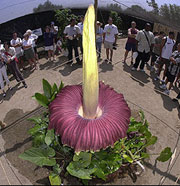WGXC-90.7 FM


A rare corpse flower blooms in New Lebanon
Apr 07, 2011 3:25 pm
 Over the next two weeks, Darrow School’s Samson Environmental Center will be host to a botanical wonder: the blooming of a rare corpse flower. Varieties of the Indonesian plant, also known as the konjac arum, boasts the largest unbranched inflorescence in the world, and the third largest flower of all known plants. The corpse flower gets its name from its distinctive odor, which many liken to the smell of rotting meat. It is a relative of the calla lily and the jack-in-the-pulpit, grows wild in the rainforests of Southeast Asia from a large underground corm. The plant first flowered in cultivation in London in 1889. Fewer than 50 of the largest variety of corpse flower, the titan arum, are known to have bloomed in the United States, with the smaller konjac arum typically found only in botanical gardens, museums, and private greenhouse collections. The large green bud of the konjac arum grows at a rate of about an inch per day, until it finally blooms into a central stem that can reach up to four feet tall, as well as a huge, purplish-brown blossom that resembles an asymmetrical collar. Darrow School’s Samson Environmental Center, built in 1988, also houses the Living Machine, an innovative wastewater treatment facility that uses a natural ecosystem to clean wastewater from campus dorms and buildings before returning it to the Hudson River watershed.
Over the next two weeks, Darrow School’s Samson Environmental Center will be host to a botanical wonder: the blooming of a rare corpse flower. Varieties of the Indonesian plant, also known as the konjac arum, boasts the largest unbranched inflorescence in the world, and the third largest flower of all known plants. The corpse flower gets its name from its distinctive odor, which many liken to the smell of rotting meat. It is a relative of the calla lily and the jack-in-the-pulpit, grows wild in the rainforests of Southeast Asia from a large underground corm. The plant first flowered in cultivation in London in 1889. Fewer than 50 of the largest variety of corpse flower, the titan arum, are known to have bloomed in the United States, with the smaller konjac arum typically found only in botanical gardens, museums, and private greenhouse collections. The large green bud of the konjac arum grows at a rate of about an inch per day, until it finally blooms into a central stem that can reach up to four feet tall, as well as a huge, purplish-brown blossom that resembles an asymmetrical collar. Darrow School’s Samson Environmental Center, built in 1988, also houses the Living Machine, an innovative wastewater treatment facility that uses a natural ecosystem to clean wastewater from campus dorms and buildings before returning it to the Hudson River watershed.

